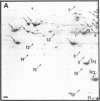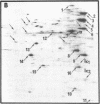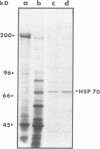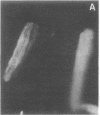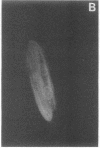Abstract
Isolated adult myocytes incubated with [35S]methionine were used to study the expression of proteins in the rat heart during the first 2 wk after either pressure or volume overload. In both models an early (2-4 d) and transient expression of three major stress proteins (heat shock protein [HSP] HSP 70, HSP 68, and HSP 58) was observed together with an increased synthesis of putative ribosomal proteins. Only traces of 35S-labeled HSPs were detected in controls and sham-operated animals. The three stress proteins were identified by their migration in two-dimensional gels, by comigration with HSPs, which had been induced in myocytes by incubation at 41 degrees C and immunoblot analysis using antisera directed against the 70-kD protein. Immunohistochemical staining of HSP 70 in rod-shaped myocytes and detection by immunoblot showed that HSP 70 was equally present and distributed in both sham-operated and overloaded hearts, and provided no evidence for a subpopulation of myocytes acutely involved in the increased expression of HSP 70. It is suggested that the transient expression of HSPs that occurs during the early adaptation of the myocardial cells to overload could confer some degree of protection to the actively growing myocytes.
Full text
PDF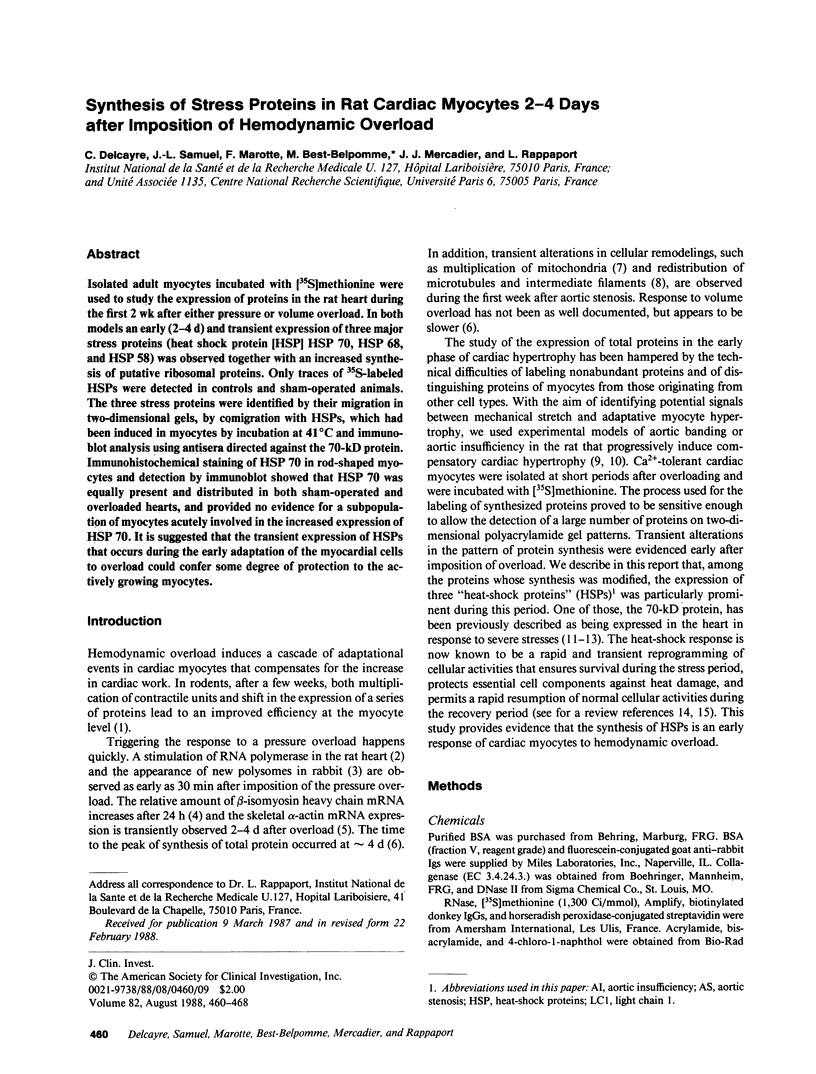
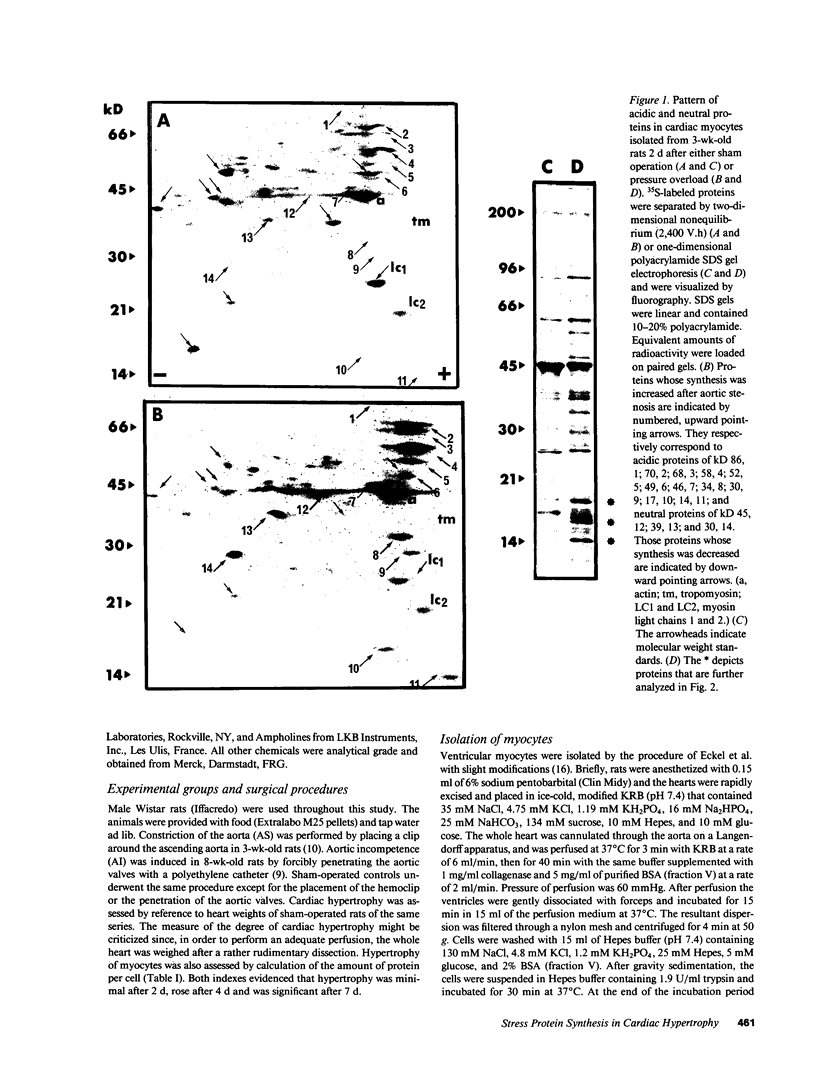
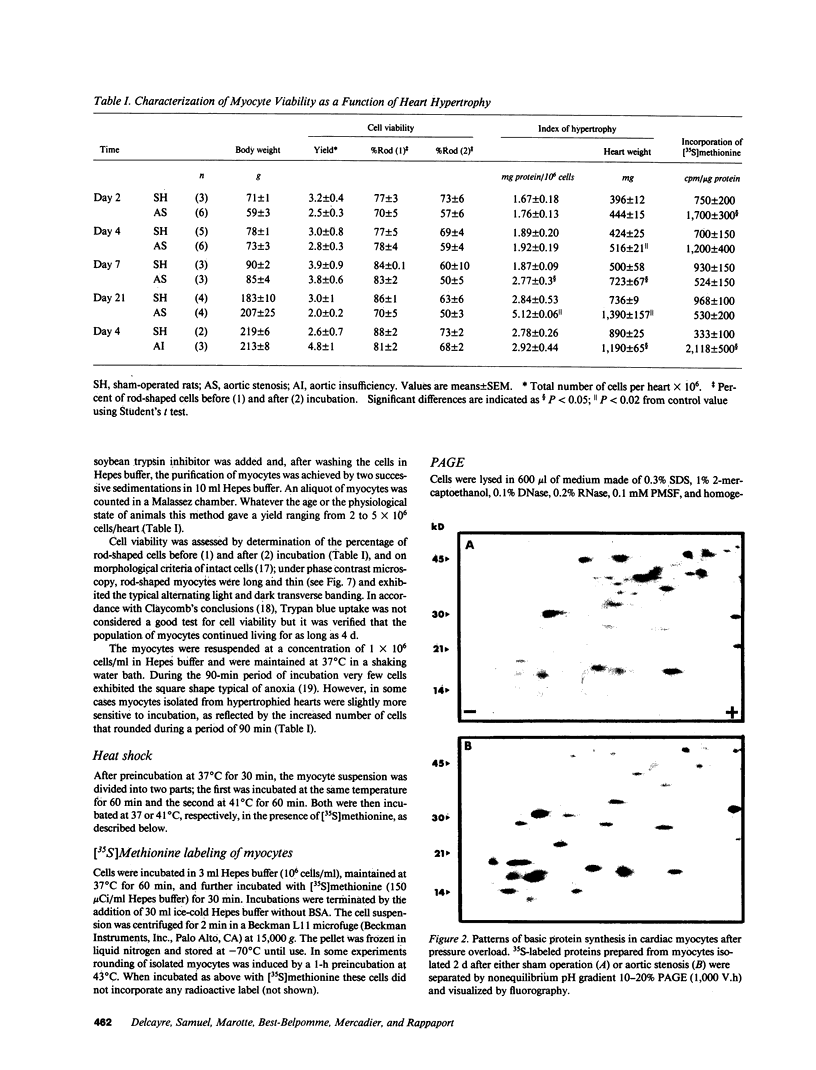
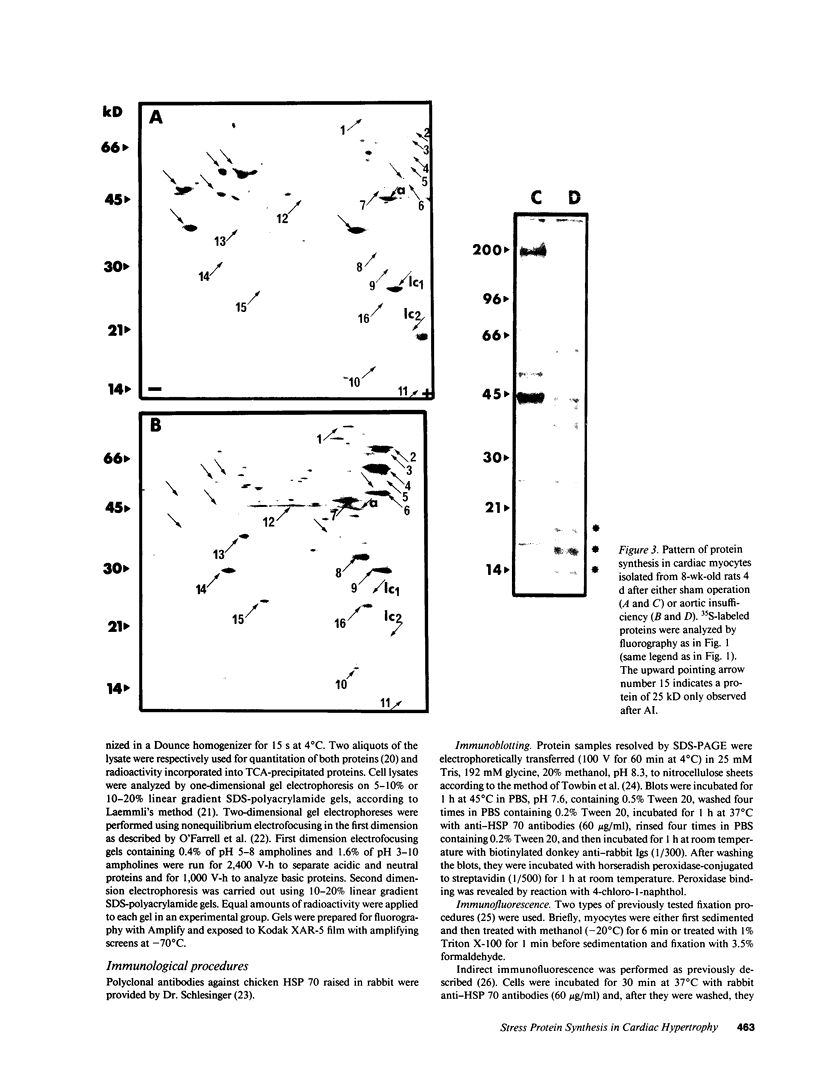
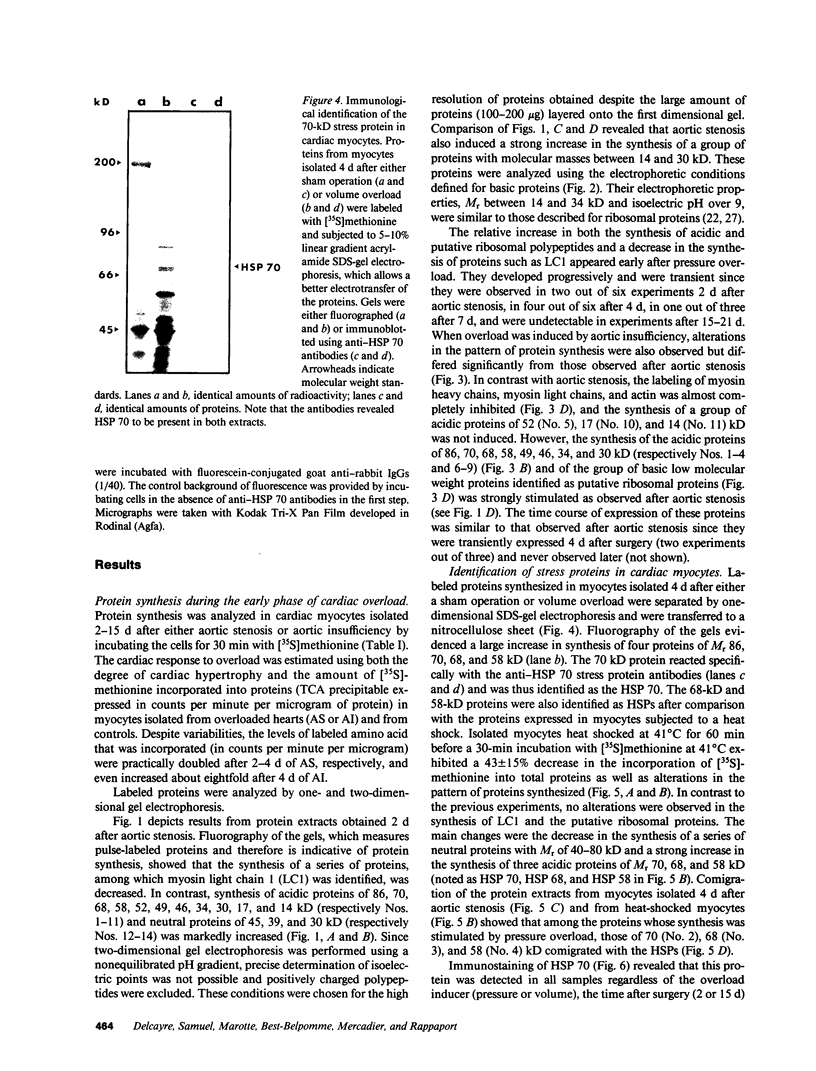
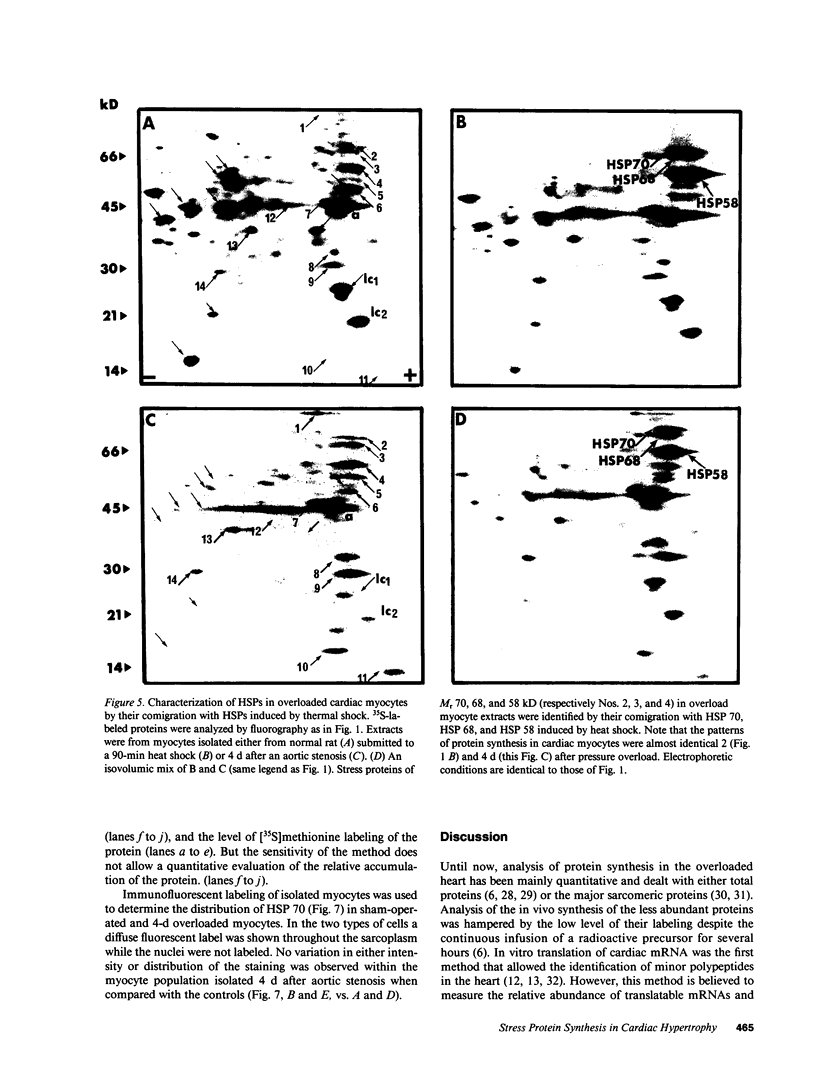
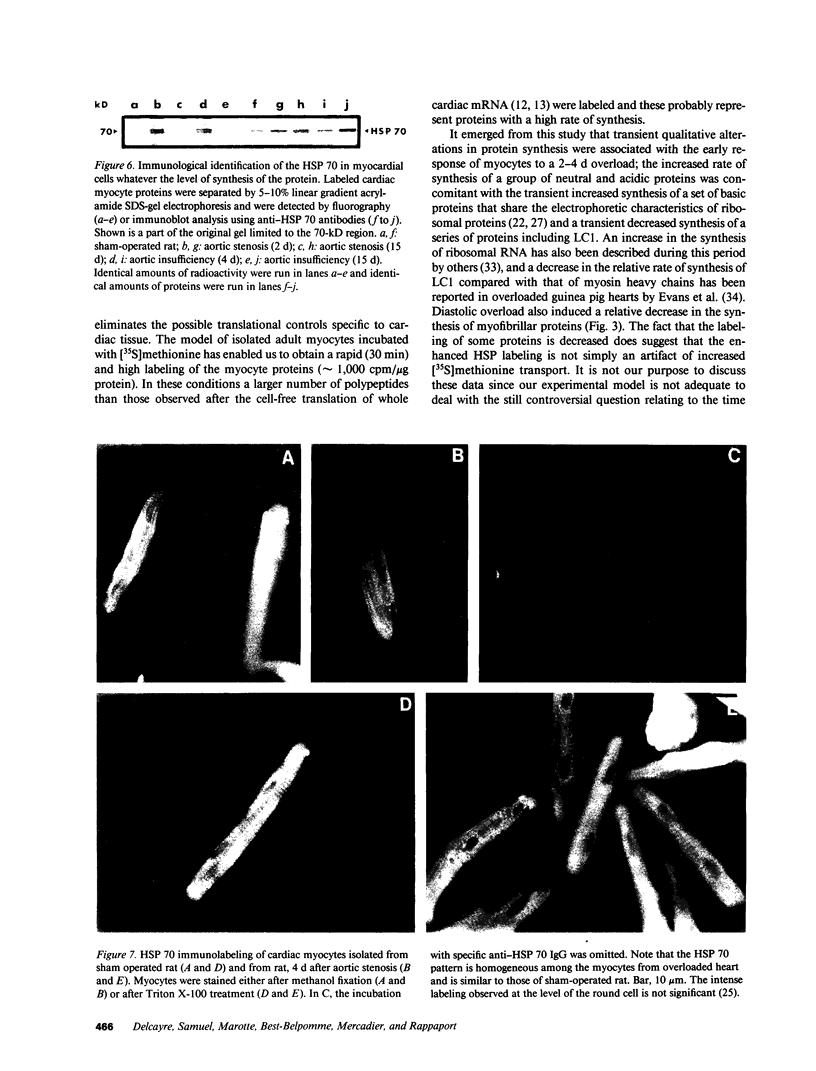
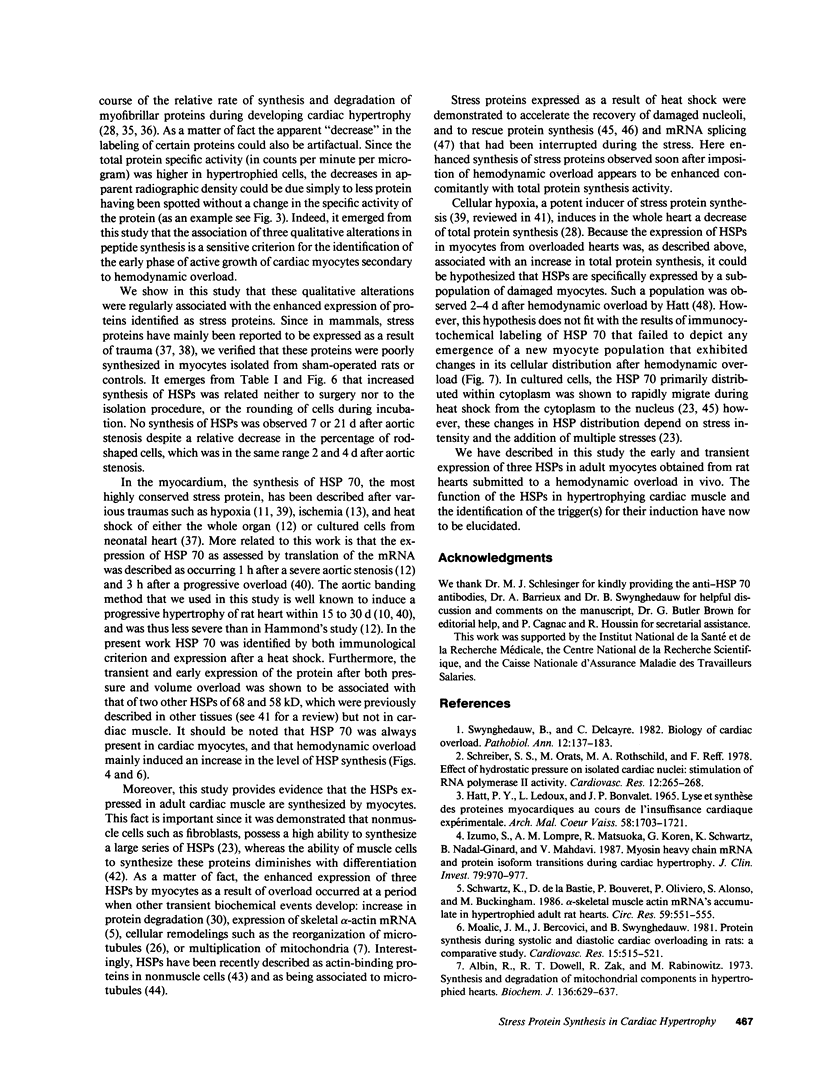
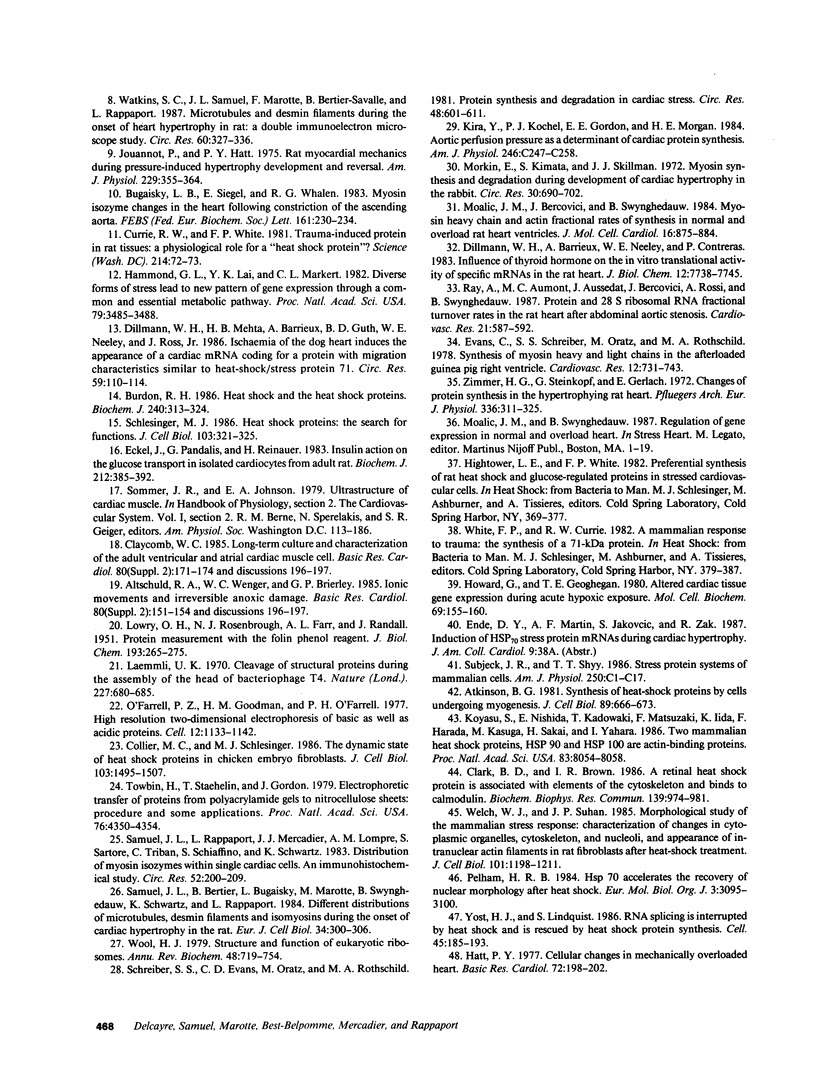
Images in this article
Selected References
These references are in PubMed. This may not be the complete list of references from this article.
- Albin R., Dowell R. T., Zak R., Rabinowitz M. Synthesis and degradation of mitochondrial components in hypertrophied rat heart. Biochem J. 1973 Nov;136(3):629–637. doi: 10.1042/bj1360629. [DOI] [PMC free article] [PubMed] [Google Scholar]
- Altschuld R. A., Wenger W. C., Brierley G. P. Ionic movements and irreversible anoxic damage. Basic Res Cardiol. 1985;80 (Suppl 2):151–154. [PubMed] [Google Scholar]
- Atkinson B. G. Synthesis of heat-shock proteins by cells undergoing myogenesis. J Cell Biol. 1981 Jun;89(3):666–673. doi: 10.1083/jcb.89.3.666. [DOI] [PMC free article] [PubMed] [Google Scholar]
- Bugaisky L. B., Siegel E., Whalen R. G. Myosin isozyme changes in the heart following constriction of the ascending aorta of a 25-day old rat. FEBS Lett. 1983 Sep 19;161(2):230–234. doi: 10.1016/0014-5793(83)81014-x. [DOI] [PubMed] [Google Scholar]
- Burdon R. H. Heat shock and the heat shock proteins. Biochem J. 1986 Dec 1;240(2):313–324. doi: 10.1042/bj2400313. [DOI] [PMC free article] [PubMed] [Google Scholar]
- Clark B. D., Brown I. R. A retinal heat shock protein is associated with elements of the cytoskeleton and binds to calmodulin. Biochem Biophys Res Commun. 1986 Sep 30;139(3):974–981. doi: 10.1016/s0006-291x(86)80273-x. [DOI] [PubMed] [Google Scholar]
- Claycomb W. C. Long-term culture and characterization of the adult ventricular and atrial cardiac muscle cell. Basic Res Cardiol. 1985;80 (Suppl 2):171–174. [PubMed] [Google Scholar]
- Collier N. C., Schlesinger M. J. The dynamic state of heat shock proteins in chicken embryo fibroblasts. J Cell Biol. 1986 Oct;103(4):1495–1507. doi: 10.1083/jcb.103.4.1495. [DOI] [PMC free article] [PubMed] [Google Scholar]
- Currie R. W., White F. P. Trauma-induced protein in rat tissues: a physiological role for a "heat shock" protein? Science. 1981 Oct 2;214(4516):72–73. doi: 10.1126/science.7280681. [DOI] [PubMed] [Google Scholar]
- Dillmann W. H., Barrieux A., Neeley W. E., Contreras P. Influence of thyroid hormone on the in vitro translational activity of specific mRNAs in the rat heart. J Biol Chem. 1983 Jun 25;258(12):7738–7745. [PubMed] [Google Scholar]
- Dillmann W. H., Mehta H. B., Barrieux A., Guth B. D., Neeley W. E., Ross J., Jr Ischemia of the dog heart induces the appearance of a cardiac mRNA coding for a protein with migration characteristics similar to heat-shock/stress protein 71. Circ Res. 1986 Jul;59(1):110–114. doi: 10.1161/01.res.59.1.110. [DOI] [PubMed] [Google Scholar]
- Eckel J., Pandalis G., Reinauer H. Insulin action on the glucose transport system in isolated cardiocytes from adult rat. Biochem J. 1983 May 15;212(2):385–392. doi: 10.1042/bj2120385. [DOI] [PMC free article] [PubMed] [Google Scholar]
- Evans C., Schreiber S. S., Oratz M., Rothschild M. A. Synthesis of myosin heavy and light chains in the afterloaded guinea pig right ventricle. Cardiovasc Res. 1978 Dec;12(12):731–743. doi: 10.1093/cvr/12.12.731. [DOI] [PubMed] [Google Scholar]
- Hammond G. L., Lai Y. K., Markert C. L. Diverse forms of stress lead to new patterns of gene expression through a common and essential metabolic pathway. Proc Natl Acad Sci U S A. 1982 Jun;79(11):3485–3488. doi: 10.1073/pnas.79.11.3485. [DOI] [PMC free article] [PubMed] [Google Scholar]
- Hatt P. Y. Cellular changes in mechanically overloaded heart. Basic Res Cardiol. 1977 Mar-Jun;72(2-3):198–202. doi: 10.1007/BF01906361. [DOI] [PubMed] [Google Scholar]
- Hatt P. Y., Ledoux C., Bonvalet J. P. Lyse et synthèse des protéines myocardiques au cours de l'insuffisance cardiaque expérimentale. (Etude au microscope électronique) Arch Mal Coeur Vaiss. 1965 Dec;58(12):1703–1721. [PubMed] [Google Scholar]
- Howard G., Geoghegan T. E. Altered cardiac tissue gene expression during acute hypoxic exposure. Mol Cell Biochem. 1986 Feb;69(2):155–160. doi: 10.1007/BF00224762. [DOI] [PubMed] [Google Scholar]
- Izumo S., Lompré A. M., Matsuoka R., Koren G., Schwartz K., Nadal-Ginard B., Mahdavi V. Myosin heavy chain messenger RNA and protein isoform transitions during cardiac hypertrophy. Interaction between hemodynamic and thyroid hormone-induced signals. J Clin Invest. 1987 Mar;79(3):970–977. doi: 10.1172/JCI112908. [DOI] [PMC free article] [PubMed] [Google Scholar]
- Jouannot P., Hatt P. Y. Rat myocardial mechanics during pressure-induced hypertrophy development and reversal. Am J Physiol. 1975 Aug;229(2):355–364. doi: 10.1152/ajplegacy.1975.229.2.355. [DOI] [PubMed] [Google Scholar]
- Kira Y., Kochel P. J., Gordon E. E., Morgan H. E. Aortic perfusion pressure as a determinant of cardiac protein synthesis. Am J Physiol. 1984 Mar;246(3 Pt 1):C247–C258. doi: 10.1152/ajpcell.1984.246.3.C247. [DOI] [PubMed] [Google Scholar]
- Koyasu S., Nishida E., Kadowaki T., Matsuzaki F., Iida K., Harada F., Kasuga M., Sakai H., Yahara I. Two mammalian heat shock proteins, HSP90 and HSP100, are actin-binding proteins. Proc Natl Acad Sci U S A. 1986 Nov;83(21):8054–8058. doi: 10.1073/pnas.83.21.8054. [DOI] [PMC free article] [PubMed] [Google Scholar]
- LOWRY O. H., ROSEBROUGH N. J., FARR A. L., RANDALL R. J. Protein measurement with the Folin phenol reagent. J Biol Chem. 1951 Nov;193(1):265–275. [PubMed] [Google Scholar]
- Laemmli U. K. Cleavage of structural proteins during the assembly of the head of bacteriophage T4. Nature. 1970 Aug 15;227(5259):680–685. doi: 10.1038/227680a0. [DOI] [PubMed] [Google Scholar]
- Moalic J. M., Bercovici J., Swynghedauw B. Myosin heavy chain and actin fractional rates of synthesis in normal and overload rat heart ventricles. J Mol Cell Cardiol. 1984 Oct;16(10):875–884. doi: 10.1016/s0022-2828(84)80024-3. [DOI] [PubMed] [Google Scholar]
- Moalic J. M., Bercovici J., Swynghedauw B. Protein synthesis during systolic and diastolic cardiac overloading in rats: a comparative study. Cardiovasc Res. 1981 Sep;15(9):515–521. doi: 10.1093/cvr/15.9.515. [DOI] [PubMed] [Google Scholar]
- Morkin E., Kimata S., Skillman J. J. Myosin synthesis and degradation during development of cardiac hypertrophy in the rabbit. Circ Res. 1972 Jun;30(6):690–702. doi: 10.1161/01.res.30.6.690. [DOI] [PubMed] [Google Scholar]
- O'Farrell P. Z., Goodman H. M., O'Farrell P. H. High resolution two-dimensional electrophoresis of basic as well as acidic proteins. Cell. 1977 Dec;12(4):1133–1141. doi: 10.1016/0092-8674(77)90176-3. [DOI] [PubMed] [Google Scholar]
- Pelham H. R. Hsp70 accelerates the recovery of nucleolar morphology after heat shock. EMBO J. 1984 Dec 20;3(13):3095–3100. doi: 10.1002/j.1460-2075.1984.tb02264.x. [DOI] [PMC free article] [PubMed] [Google Scholar]
- Ray A., Aumont M. C., Aussedat J., Bercovici J., Rossi A., Swynghedauw B. Protein and 28S ribosomal RNA fractional turnover rates in the rat heart after abdominal aortic stenosis. Cardiovasc Res. 1987 Aug;21(8):587–592. doi: 10.1093/cvr/21.8.587. [DOI] [PubMed] [Google Scholar]
- Samuel J. L., Bertier B., Bugaisky L., Marotte F., Swynghedauw B., Schwartz K., Rappaport L. Different distributions of microtubules, desmin filaments and isomyosins during the onset of cardiac hypertrophy in the rat. Eur J Cell Biol. 1984 Jul;34(2):300–306. [PubMed] [Google Scholar]
- Samuel J. L., Rappaport L., Mercadier J. J., Lompre A. M., Sartore S., Triban C., Schiaffino S., Schwartz K. Distribution of myosin isozymes within single cardiac cells. An immunohistochemical study. Circ Res. 1983 Feb;52(2):200–209. doi: 10.1161/01.res.52.2.200. [DOI] [PubMed] [Google Scholar]
- Schlesinger M. J. Heat shock proteins: the search for functions. J Cell Biol. 1986 Aug;103(2):321–325. doi: 10.1083/jcb.103.2.321. [DOI] [PMC free article] [PubMed] [Google Scholar]
- Schreiber S. S., Evans C. D., Oratz M., Rothschild M. A. Protein synthesis and degradation in cardiac stress. Circ Res. 1981 May;48(5):601–611. doi: 10.1161/01.res.48.5.601. [DOI] [PubMed] [Google Scholar]
- Schreiber S. S., Oratz M., Rothschild M. A., Reff F. Effect of hydrostatic pressure on isolated cardiac nuclei: Stimulation of RNA polymerase II activity. Cardiovasc Res. 1978 May;12(5):265–268. doi: 10.1093/cvr/12.5.265. [DOI] [PubMed] [Google Scholar]
- Schwartz K., de la Bastie D., Bouveret P., Oliviéro P., Alonso S., Buckingham M. Alpha-skeletal muscle actin mRNA's accumulate in hypertrophied adult rat hearts. Circ Res. 1986 Nov;59(5):551–555. doi: 10.1161/01.res.59.5.551. [DOI] [PubMed] [Google Scholar]
- Subjeck J. R., Shyy T. T. Stress protein systems of mammalian cells. Am J Physiol. 1986 Jan;250(1 Pt 1):C1–17. doi: 10.1152/ajpcell.1986.250.1.C1. [DOI] [PubMed] [Google Scholar]
- Swynghedauw B., Delcayre C. Biology of cardiac overload. Pathobiol Annu. 1982;12:137–183. [PubMed] [Google Scholar]
- Towbin H., Staehelin T., Gordon J. Electrophoretic transfer of proteins from polyacrylamide gels to nitrocellulose sheets: procedure and some applications. Proc Natl Acad Sci U S A. 1979 Sep;76(9):4350–4354. doi: 10.1073/pnas.76.9.4350. [DOI] [PMC free article] [PubMed] [Google Scholar]
- Watkins S. C., Samuel J. L., Marotte F., Bertier-Savalle B., Rappaport L. Microtubules and desmin filaments during onset of heart hypertrophy in rat: a double immunoelectron microscope study. Circ Res. 1987 Mar;60(3):327–336. doi: 10.1161/01.res.60.3.327. [DOI] [PubMed] [Google Scholar]
- Welch W. J., Suhan J. P. Morphological study of the mammalian stress response: characterization of changes in cytoplasmic organelles, cytoskeleton, and nucleoli, and appearance of intranuclear actin filaments in rat fibroblasts after heat-shock treatment. J Cell Biol. 1985 Oct;101(4):1198–1211. doi: 10.1083/jcb.101.4.1198. [DOI] [PMC free article] [PubMed] [Google Scholar]
- Wool I. G. The structure and function of eukaryotic ribosomes. Annu Rev Biochem. 1979;48:719–754. doi: 10.1146/annurev.bi.48.070179.003443. [DOI] [PubMed] [Google Scholar]
- Yost H. J., Lindquist S. RNA splicing is interrupted by heat shock and is rescued by heat shock protein synthesis. Cell. 1986 Apr 25;45(2):185–193. doi: 10.1016/0092-8674(86)90382-x. [DOI] [PubMed] [Google Scholar]
- Zimmer H. G., Steinkopff G., Gerlach E. Changes of protein synthesis in the hypertrophying rat heart. Pflugers Arch. 1972;336(4):311–325. doi: 10.1007/BF00586956. [DOI] [PubMed] [Google Scholar]








